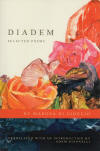Diadem
Despite a several-decades-long history of publication in the poet’s homeland of Uruguay, prior to the publication of Diadem: Selected Poems the only published translations into English of Marosa Di Giorgio’s work were her 1965 collection The History of Violets (Historial de las violetas) (Ugly Duckling Presse, 2010) and a selection of her work in the anthology Hotel Lautréamont: Contemporary Poetry from Uruguay (Shearsman, 2011). This is slim representation for a poet who, as translator Adam Giannelli relates in his introduction, “like Whitman . . . expanded the same work throughout her career,” ultimately gathering fourteen books as her collected poetry in Los papeles salvajes (“The Wild Papers”) which in “the most recent version appeared in 2008, and gathered in a single volume nearly seven hundred pages of poetry.”
Despite a several-decades-long history of publication in the poet’s homeland of Uruguay, prior to the publication of Diadem: Selected Poems the only published translations into English of Marosa Di Giorgio’s work were her 1965 collection The History of Violets (Historial de las violetas) (Ugly Duckling Presse, 2010) and a selection of her work in the anthology Hotel Lautréamont: Contemporary Poetry from Uruguay (Shearsman, 2011). This is slim representation for a poet who, as translator Adam Giannelli relates in his introduction, “like Whitman . . . expanded the same work throughout her career,” ultimately gathering fourteen books as her collected poetry in Los papeles salvajes (“The Wild Papers”) which in “the most recent version appeared in 2008, and gathered in a single volume nearly seven hundred pages of poetry.”
Diadem goes a long way toward offering a fuller range of Di Giorgio’s work to an English audience. Even if it represents only a small fraction of her overall output, this collection clues in those not already in the know. Giannelli pulls poems primarily from out the latter half of the poet’s life, reproducing little of anything that has already appeared in English translation while covering a two-decade span (1965-87) of publications. Giannelli argues that although he’s drawn from half a dozen books published over nearly twice as many years, “the book can also be read from cover to cover as an interrelated series.” And this proves to be quite true—no doubt largely due, as noted above, to Di Giorgio’s consciously composing her individual books as forming a larger whole.
Di Giorgio’s poems are written in a lucid prose that suits the quite dreamlike and ultra-real landscapes described. Threads within poems from separate books connect. While none of the poems are full narratives, they do contain narrative. Gianelli refers to the Alice in Wonderland quality found in much of the work, and indeed one collection he selects from here is entitled The March Hare. Di Giorgio often references her family and her childhood home outside of the city. Insects and flowers are predominant fixtures in the poems alongside the narrator and an array of magical-seeming creatures and events.
In one poem the speaker declares she might perhaps “eat a butterfly”:
The daytime butterfly won’t do, it’s too light; it’d be like trying to quench thirst with a few drops of dew. The night butterfly is very special; it’s firm, plump, entirely edible; eyes, legs, wings; all of it. Sometimes, it tastes wretched; other times, it doesn’t; it’s like herbs, fresh meat. But how is a butterfly born, anyway? A tiny egg on a “daylily”? a flower? It cracks open, lets out the nun, the little carcass. I think it only takes one morning for it to become an adult and fly around and about the flowers. That must be the process. Towards nocturnal butterflies, I admit, I harbor some reservations. But it’s best not to think of it. Oh, God! It just fell! While I was musing on all this, it fell. It’s big, almost like a bird; it’s beige with wide black wings: perhaps . . . a bit monstrous; but at the same time it looks like little Saint Teresa; I’ve snared it.
Later in life Di Giorgio began to offer staged readings of her poems. She “performed recitals across the globe” and “a version of the show was released in 1994 and included as a compact disc with the title Diadema inside her last book.” In her own words: “The word diadem occurs within the recital, but it’s also a garland of poems selected from different books.” Giannelli locates this as the source of his title, noting Di Giorgio’s Catholicism, how she claimed her first poem came as a vision from the Virgin Mary, and that “The Virgin continually appears throughout her poems, and the diadem serves as an image of authority and femininity. A full circle it is also a symbol of plenitude, and of eternity.” As Di Giorgio describes in a poem:
I wander through the old orchard—Isabel, Ana—through the old houses; I’d like to be a woman in one of these houses, a city woman, but I’m the Virgin; they don’t realize; I search for another deserted village, other fields of hemp. The wind whistles. The wolves are eating the lambs. On my diadem fall stars like tears, fall roses and gladioli, black dahlias.
Having the original language on facing pages further enhances the quality of the book. Di Giorgio’s work is well treated, and Giannelli has taken obvious care with his presentation. Hopefully either he or others are at work translating the rest of her work, the poetry as well as her novel and three books of erotic tales.





